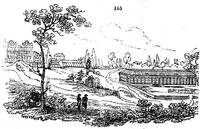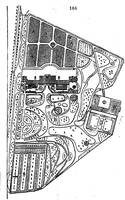491. The botanic garden at Warsaw (fig. 165.) contains upwards of fifteen acres, and in 1824 the catalogue enumerated upwards of 10,000 species. The plants are arranged according to the natural system. The following are details of the plan (fig. 166.): - A, Botanical nursery. B, Orchard. C, Nursery of foreign trees and shrubs. D, Vineyard. a, Astronomical observatory. b, Dwelling-houses of the professors and gardeners. c, Theatre, in which were formerly noted plays for the Polish court. d, Small chapel in an old gravel pit, formerly used as a burying-ground to the barracks of the royal guard, e, Reservoir of water. f, Greenhouses and vinery. g, Fig-house. h, Brick-built pits with flues. i, Hotbed frames. k, Sheds. l, Dial and compass. m, Domestic offices. n, Summer station for the greenhouse plants. o, Pumps. p, Shrubbery. q, Stations for plants. r, Evergreen shrubs, s, Compost ground. The view of the garden shows the ancient greenhouse, observatory, and modern plant-houses, as conspicuous objects. Of the surface of the situation we have a perfect recollection, and know it to be very much varied: the soil is light, sandy, and gravelly; and the surrounding scenery is the most agreeable in the neighbourhood of Warsaw. This garden was not injured by the taking of Warsaw by the Russians, in 1831. The oldest botanic garden in Poland, however, is that of Wilna, founded by Catherine, soon after the dismemberment of that country; the most thriving is that of Cracow, placed, in 1812, under the direction of Professor Oestricher, a zealous botanist. A garden was also begun, about 1810, in Warsaw, on the steep banks of the Vistula. Of the original Warsaw garden, of which a catalogue was published towards the middle of the last century, we could, in 1813, procure no account. Count Benningsen had an excellent botanic garden at his seat near Wilna, which, as already observed, was destroyed, and the chateau burned down, in 1812. It was rich in hardy plants. At Pulhawa the Princess Isabella Czartoryska has a considerable collection, and used frequently to send her gardener (Savage), now deceased, to England, to procure the newest exotics. A few flowers are cultivated in some of the wealthier citizens' gardens around Warsaw, and a few in gardens of the conventual institutions; but, in a general point of view, they are as uncommon in Poland as in Russia. In both countries a few may occasionally be seen in the markets, which have been gathered in the fields, and brought in by the peasants; these are purchased by the minor nobles, to decorate their rooms; by the monks, to display on their altars; or by devotees, to present to the Virgin, or the image of their patron saint. The floors of the higher classes, in Poland, are often strewed with the leaves of the A'corus Calamus, which abounds in the marshes of that country. In some districts, towards Courland, the spray of the spruce fir is used for this purpose; a practice, as Mary Woolstonecraft has remarked, common in Sweden and Norway.



